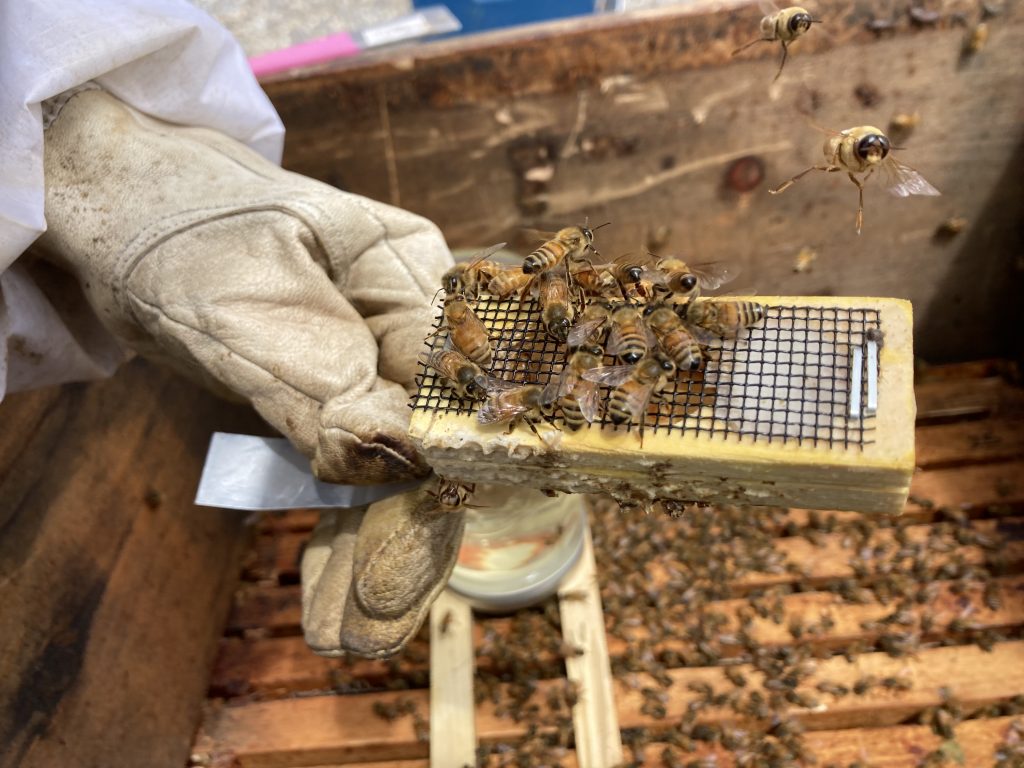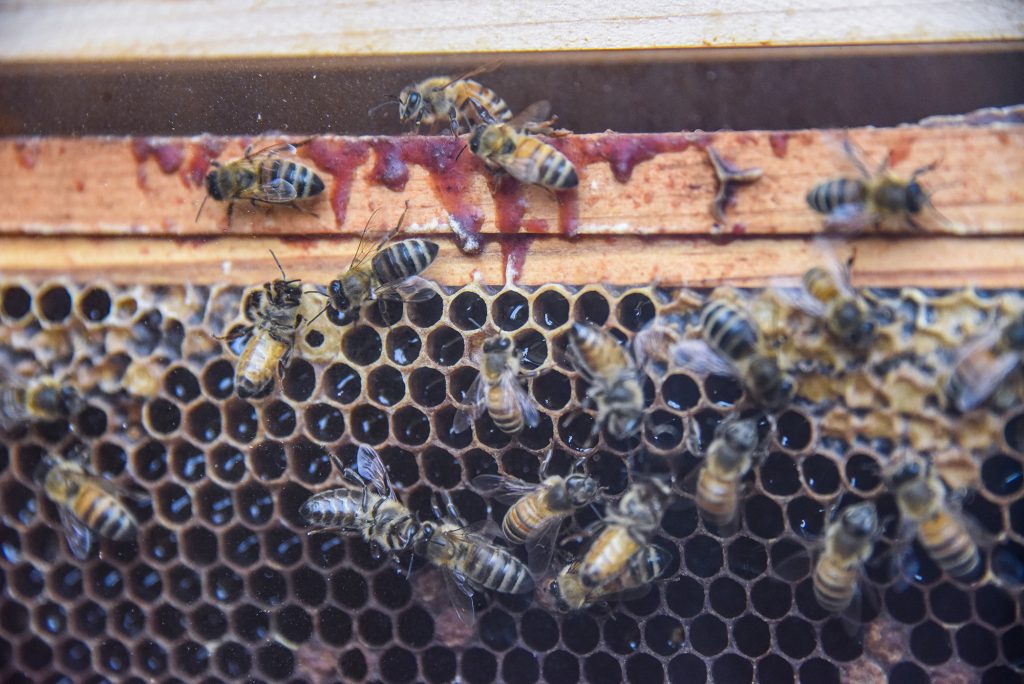I always imagine what our new Learning Apiary must look like to visitors—walking up to it for the first time, it almost looks like a garden picture with a beautiful apiary in the middle. But your friendly beekeeper walks through the image and suddenly you notice all the bees buzzing behind the screen. These bees are like many hundreds of thousands of hardworking members of staff, pollinating our plants.
Let’s take a look at 14 of the most important bees we have here at the Gardens—the queens.
Each hive only has one, easily identified by her elongated abdomen and the bright blue dot we paint on her thorax. Whenever we introduce a new queen to our apiary, we add this to make her easy to see, but also to let us know that she was born in 2020 (each year is a different color). A queen can live for up to four years and we want to keep track of her age, so if we like her genetics, we can continue them on. Blue is for bees born in the year ending in a 0 or 5, white for years 1 or 6, yellow for years 2 or 7, red for years 3 or 8, and green for years 4 or 9.
One of the most frequently asked questions is where the queen is in the observation hive. Since queens only leave the hive to mate or when they swarm, they are not used to sunshine. In other words, whenever we open up the door to the observation hive, she is more likely to run back into the darkness. She will also only lay in the first three frames of comb and the rest will be filled with pollen and honey. When she eventually runs out of space in the front, she moves into the back.
I know you are all wondering what the queen does all day while ruling over her hive. She has the important job of laying eggs. A good queen can lay between 1,500 and 2,000 eggs per day, which is equivalent to her body weight.
Where do we get our queens? When we originally order our packages of bees, they contain a three-pound box of worker bees accompanied by an individual mated queen in her own box. Once installed, we introduce the queen by placing her box between frames, and if the worker bees accept her, they will free her by removing the door to the box (a sugar plug).
Once she has started laying eggs, the hive gets larger and larger until they all need more space. This is when they will start planning to swarm, meaning the queen and ⅓ of the workers will leave the hive to find a new home. When they leave the original hive, they leave behind a few queen cells and some eggs the will potentially become queens as well.
However, here at the Gardens, we don’t want them to swarm on their own. Instead, we create an “artificial swarm” when the hives get too crowded. To do this, we take the queen and workers and install them in a new box. With the original hive now queen-less, it is a waiting game until the new baby queens start to emerge from their cells. Once the first queen arrives, she assures her reign by stabbing the other queen cells before they have a chance to emerge.
If another queen emerges at the same time, they duel and the winner takes all. Once there is only one queen, it is time for her to take her virgin mating flight, leaving the hive and mating with the drone bees. Mating never takes place in the hive itself, and each queen will only mate once in her life. She can mate with up to 20 drones during her flight before she heads back to the hive to start laying eggs. She can lay two different types of eggs: drones, which are unfertilized eggs that are placed into larger combs, and worker bees, which are fertilized eggs.
Queens also produce the pheromone known as “queen signals,” produced in the mandibular gland. This pheromone inspires cohesive behavior amongst the hive, stops the production of new queens, stops any egg-laying workers (they can only lay unfertilized eggs), and enhances work morale in the hive (Bortolotti, Costa 2014).
A little piece of pheromone is shared with every member of the colony, helping to identify which worker belongs with which queen. For example, if bees try to go into another hive, the guards at the entrance will reject them because they smell different. However, when a hive becomes queen-less, the pheromone ceases too. This is a signal to the worker bees to rear a new queen. Incidentally, they also begin to clean the hive at this time, too, since there’s less brood to take care of (and bees are programmed to keep busy).
This absence of pheromone can also lead to colony fail as bees, rudderless, drift between colonies and no longer reproduce more workers. Here at the Gardens, we will occasionally make our hives queen-less to help promote cleanliness if we notice our bees aren’t cleaning regularly; this also prevents swarming. When we feel the morale of the hive is getting low, we will introduce a new queen and let them build back up.
If you want to learn more about beekeeping and our apiary, please come and join our beekeeping intern Monday, Wednesday, and Thursday afternoons to get an inside look at our hives and the world of a beekeeper. 
Sources:
Bortolotti, L. Costa, C. 2014 Neurobiology of Chemical Communication. CRC Press/Taylor & Francis. https://www.ncbi.nlm.nih.gov/books/NBK200983/

